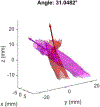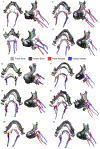Quantifying Tumor and Vasculature Deformations during Laryngoscopy
- PMID: 34993696
- PMCID: PMC9035291
- DOI: 10.1007/s10439-021-02896-8
Quantifying Tumor and Vasculature Deformations during Laryngoscopy
Abstract
Retractors and scopes used in head and neck surgery to provide adequate surgical exposure also deform critical structures in the region. Surgeons typically use preoperative imaging to plan and guide their tumor resections, however the large tissue deformation resulting from placement of retractors and scopes reduces the utility of preoperative imaging as a reliable roadmap. We quantify the extent of tumor and vasculature deformation in patients with tumors of the larynx and pharynx undergoing diagnostic laryngoscopy. A mean tumor displacement of 1.02 cm was observed between the patients' pre- and intra-operative states. Mean vasculature displacement at key bifurcation points was 0.99 cm. Registration to the hyoid bone can reduce tumor displacement to 0.67 cm and improve carotid stem angle deviations but increase overall vasculature displacement. The large deformation results suggest limitations in reliance on preoperative imaging and that using specific landmarks intraoperatively or having more intraoperative information could help to compensate for these deviations and ultimately improve surgical success.
Keywords: Intraoperative deformation; Laryngeal cancer; Transoral surgery; Tumor deformation; Vasculature deformation.
© 2021. Biomedical Engineering Society.
Conflict of interest statement
CONFLICTS OF INTEREST
No benefits in any form have been or will be received from a commercial party related directly or indirectly to the subject of this manuscript.
Figures








References
-
- Barrett WA, and Mortensen EN Interactive live-wire boundary extraction. Medical Image Analysis 1:, 1997. - PubMed
-
- Besl PJ, and McKay ND A Method for Registration of 3D-Shapes. IEEE Transactions on Pattern Analysis and Machine Inteligence 14:239–256, 1992.
-
- Bessen SY, Wu X, Sramek MT, Shi Y, Pastel D, Halter R, and Paydarfar JA Image-guided surgery in otolaryngology: A review of current applications and future directions in head and neck surgery. Head and Neck 43:, 2021. - PubMed
-
- Dice LR Measures of the Amount of Ecologic Association Between Species. Ecology 26:297–302, 1945.
MeSH terms
Grants and funding
LinkOut - more resources
Full Text Sources
Medical

